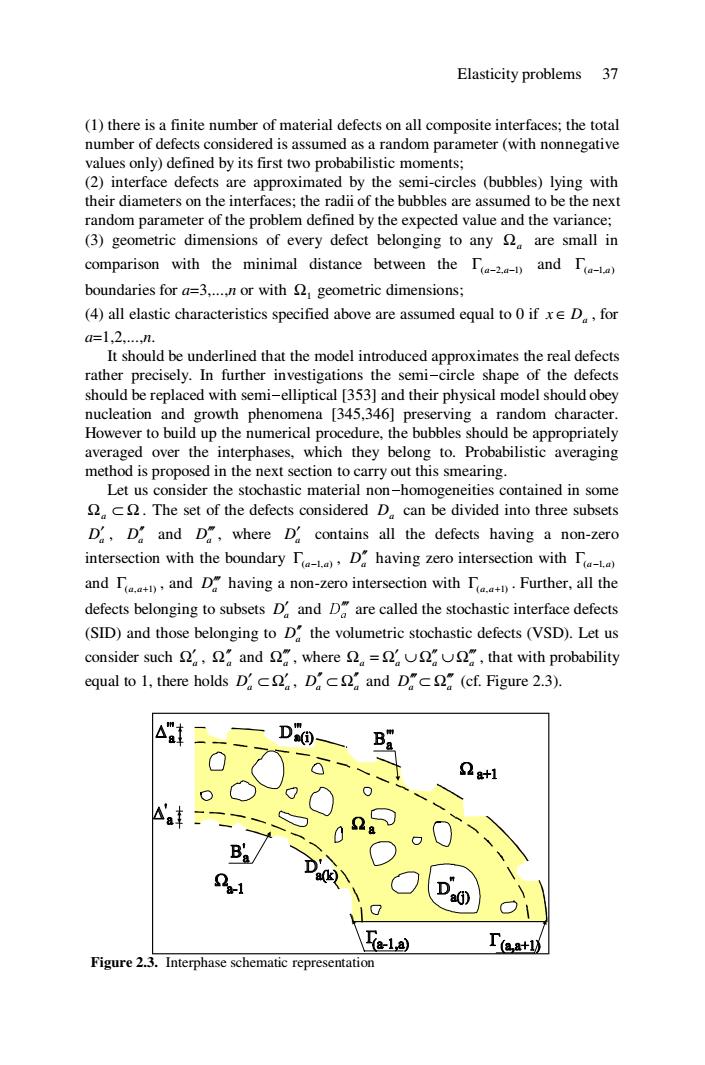正在加载图片...

Elasticity problems 37 (1)there is a finite number of material defects on all composite interfaces;the total number of defects considered is assumed as a random parameter(with nonnegative values only)defined by its first two probabilistic moments; (2)interface defects are approximated by the semi-circles (bubbles)lying with their diameters on the interfaces;the radii of the bubbles are assumed to be the next random parameter of the problem defined by the expected value and the variance; (3)geometric dimensions of every defect belonging to any are small in comparison with the minimal distance between the I2 and I boundaries for a=3,...,n or with geometric dimensions; (4)all elastic characteristics specified above are assumed equal to 0 if x D.,for =1,2n. It should be underlined that the model introduced approximates the real defects rather precisely.In further investigations the semi-circle shape of the defects should be replaced with semi-elliptical [353]and their physical model should obey nucleation and growth phenomena [345,346]preserving a random character. However to build up the numerical procedure,the bubbles should be appropriately averaged over the interphases,which they belong to.Probabilistic averaging method is proposed in the next section to carry out this smearing. Let us consider the stochastic material non-homogeneities contained in some c.The set of the defects considered D.can be divided into three subsets D2,D and D,where D contains all the defects having a non-zero intersection with the boundary ID having zero intersection with T and T and D having a non-zero intersection with IFurther,all the defects belonging to subsets D and D are called the stochastic interface defects (SID)and those belonging to D the volumetric stochastic defects(VSD).Let us consider such and where =that with probability equal to 1,there holds DD and D(cf.Figure 2.3). D0— 0时1 a0) 丁e》 Figure 2.3.Interphase schematic representationElasticity problems 37 (1) there is a finite number of material defects on all composite interfaces; the total number of defects considered is assumed as a random parameter (with nonnegative values only) defined by its first two probabilistic moments; (2) interface defects are approximated by the semi-circles (bubbles) lying with their diameters on the interfaces; the radii of the bubbles are assumed to be the next random parameter of the problem defined by the expected value and the variance; (3) geometric dimensions of every defect belonging to any Ωa are small in comparison with the minimal distance between the Γ(a−2,a−1) and Γ(a−1,a) boundaries for a=3,...,n or with Ω1 geometric dimensions; (4) all elastic characteristics specified above are assumed equal to 0 if Da x ∈ , for a=1,2,...,n. It should be underlined that the model introduced approximates the real defects rather precisely. In further investigations the semi-circle shape of the defects should be replaced with semi-elliptical [353] and their physical model should obey nucleation and growth phenomena [345,346] preserving a random character. However to build up the numerical procedure, the bubbles should be appropriately averaged over the interphases, which they belong to. Probabilistic averaging method is proposed in the next section to carry out this smearing. Let us consider the stochastic material non-homogeneities contained in some Ωa ⊂ Ω . The set of the defects considered Da can be divided into three subsets Da ′ , Da ′′ and Da ′′′ , where Da ′ contains all the defects having a non-zero intersection with the boundary Γ(a −1,a) , Da ′′ having zero intersection with Γ(a −1,a) and Γ(a,a+1) , and Da ′′′ having a non-zero intersection with Γ(a,a+1) . Further, all the defects belonging to subsets Da ′ and Da ′′′ are called the stochastic interface defects (SID) and those belonging to Da ′′ the volumetric stochastic defects (VSD). Let us consider such Ωa ′ , Ωa ′′ and Ωa ′′′ , where a a a Ωa Ω = Ω′ ∪ Ω′′ ∪ ′′′ , that with probability equal to 1, there holds Da Ωa ′ ⊂ ′ , Da Ωa ′′ ⊂ ′′ and Da Ωa ′′′⊂ ′′′ (cf. Figure 2.3). Figure 2.3. Interphase schematic representation